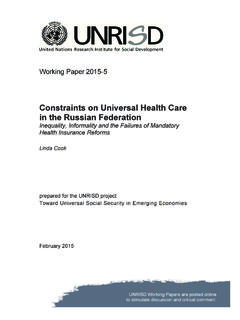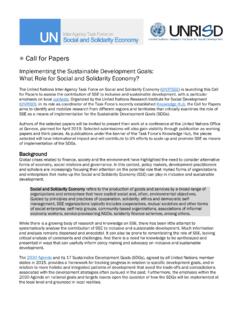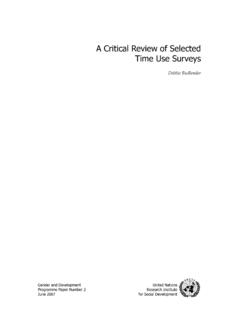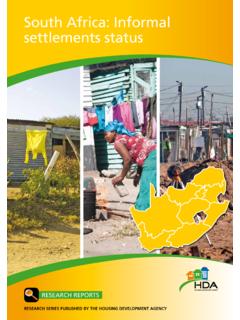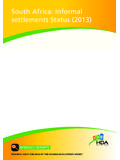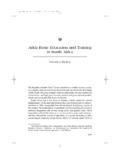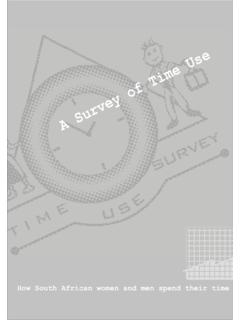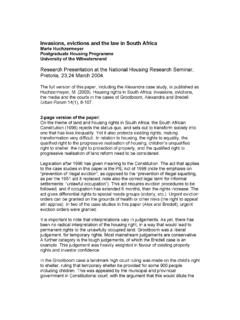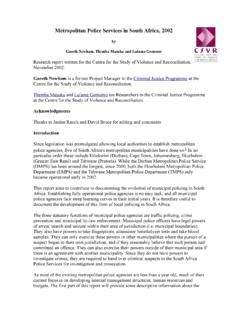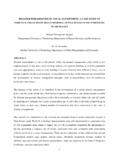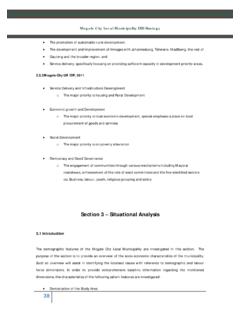Transcription of Health Care Inequity in South Africa and the Public ...
1 Health care Inequity IN South Africa AND THE Public / private MIX Haroon Wadee1, Lucy Gilson1, Michael Thiede2, Okore Okorafor2, Di McIntyre2 Draft paper prepared for the RUIG/UNRISD project on Globalization, Inequality and Health , a collaborative international project forming part of the RUIG research programme on The Social Challenge of Development September 2003 Affiliations, disclaimer and acknowledgement 1. Centre for Health Policy, School of Public Health , University of Witwatersrand 2. Health Economics Unit, University of Cape Town This paper reports work in progress. All comments on these initial analyses will be welcomed. Please send comments to Haroon Wadee: The opinions expressed are those of the authors alone, and do not reflect the views or policies of any organisation.
2 Funding for the research programme on the Social Challenge of Development, from the R seau Universitaire International de Gen ve / Geneva International Academic Network (RUIG/GIAN)) is gratefully acknowledged. 1 The United Nations Research Institute for Social Development (UNRISD) is an autonomous agency engaging in multidisciplinary research on the social dimensions of contemporary problems affecting development. Its work is guided by the conviction that, for effective development policies to be formulated, an understanding of the social and political context is crucial. The Institute attempts to provide governments, development agencies, grassroots organizations and scholars with a better understanding of how development policies and processes of economic, social and environmental change affect different social groups.
3 Working through an extensive network of national research centres, UNRISD aims to promote original research and strengthen research capacity in developing countries. Current research programmes include: Civil Society and Social Movements; Democracy, Governance and Human Rights; Identities, Conflict and Cohesion; Social Policy and Development; and Technology, Business and Society. A list of the Institute s free and priced publications can be obtained by contacting the Reference Centre. UNRISD, Palais des Nations 1211 Geneva 10, Switzerland Tel: (41 22) 9173020 Fax: (41 22) 9170650 E-mail: Web: Copyright United Nations Research Institute for Social Development (UNRISD).
4 This is not a formal UNRISD publication. The responsibility for opinions expressed in signed studies rests solely with their author(s), and availability on the UNRISD Web site ( ) does not constitute an endorsement by UNRISD of the opinions expressed in them. No publication or distribution of these papers is permitted without the prior authorization of the author(s), except for personal use. 2 ABSTRACT This working paper presents information and analyses of Health care Inequity in South Africa , with specific reference to what Health economists term the Public - private mix in Health care . The paper identifies the apartheid legacy of disadvantage in terms of Health status and inequitable access to Health care , and outlines Health policy initiatives since draws together household survey data and other evidence to highlight three aspects of the South African Health system since that date: 1.
5 Increased use of the private sector (all forms of provider) across population groups; 2. stagnation of government funding for publicly-provided Health care , which has implications for quality of care and household utilisation preferences; 3. cost escalation in, growth of, and attraction of Health personnel to, the private sector, and the implications this has for the sustainability of the overall Health system, given household utilisation preferences. This working paper largely draws upon existing sources and material, but also includes a new analysis of Health care utilisation data. The paper provides background material for further assessment of the potential for Public - private interactions to support greater cross-subsidy between population groups.
6 31. THE CONTEXT OF Health AND Health care IN South Africa The apartheid legacy of disadvantage A range of household surveys provide data on the extent and nature of socio-economic dis-advantage in South Africa . These include the 1992/93 Project for Statistics on Living Standards and Development (LSDS), the annual October Household Surveys (OHS) conducted by Statistics South Africa , a 1994/5 survey of Health inequalities (Hirschowitz and Orkin 1995) the South African Participatory Poverty Assessment (SA-PPA 1997), and the 1996 population census. Analysis of these surveys (see, for example, Reconstruction and Development Programme 1995; May et al.)
7 1995; May 1998) suggests that the most crucial indicators of dis-advantage include: race (African and to a lesser extent coloured1); housing; access to energy sources; water and sanitation; educational status; employment status; food access and nutritional status; geographic location (especially rural residence); fragmentation of the family, especially labour migrancy; gender (especially single mothers and female heads of households) and age (young children and the elderly who have no wider family support). As the human development disparities of South Africa are largely attributable to the racially discriminatory economic and social policies of apartheid (Gilson and McIntyre 2002) they can clearly be regarded as unacceptable inequalities.
8 As noted in the 1998 Poverty and Inequality report, many of the distortions and dynamics introduced by apartheid continue to reproduce poverty and perpetuate inequality. The correct identification of these and the introduction of remedial policies have been identified as priorities by both government and civil society (May 1998: 2 - authors emphasis). If government resources are to be allocated in line with these priorities, groups who fare the worst in these human development indicators should be awarded priority in the allocation of these resources. The disparities in socio-economic status have also contributed to inequalities in Health status in South Africa .
9 Gilson and McIntyre (2002) found that there are significant differences in the incidence of ill- Health between different race groups and geographic areas as well as between groups of different socio-economic status. Using 1992/93 data, the infant mortality rate (IMR) of the African population was found to be nearly six times greater than that of the white population. In addition, the IMR varied by a factor of nearly 5 between provinces and by nearly 3 between the highest and lowest household income quintiles. The authors also found that income is a mediating factor in the relationship between race and Health status. For the African and coloured populations, there is a clear trend of declining IMR with rising income.
10 The Health system legacy of apartheid Health policy in the apartheid era, like all government action, served the dominant objective of maintaining economic and political power for the white population group. It was shaped to maintain a difference in the quality of life enjoyed by different population groups and so promote political support for the National Party (Price 1986). As a result, the Health system inherited by the new government in 1994 can be characterised as: centralised and undemocratic ( Health Systems Trust 1996); 1 The use of the terms African , white , coloured and Indian reflects a statutory stratification of the South African population in terms of the former Population Registration Act.
